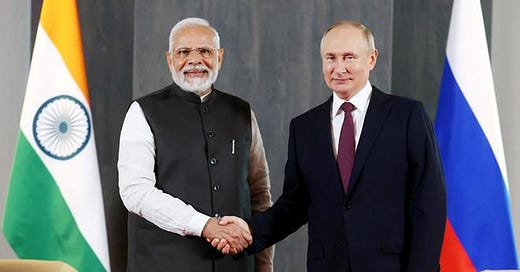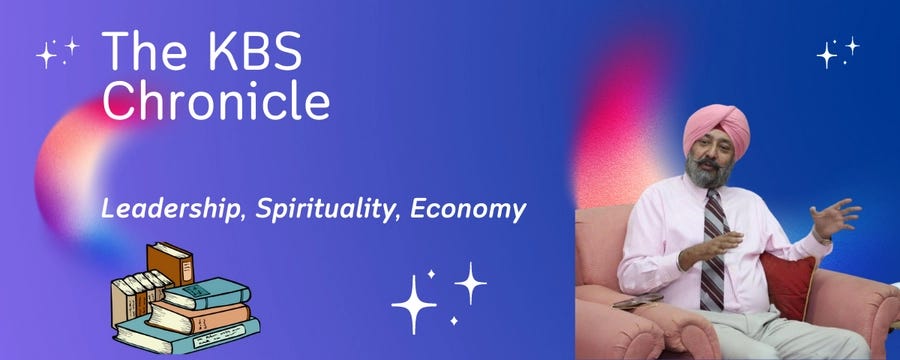PM Modi's State Visit to Moscow: Objectives and Expectations
To Russia With Love. Aims to reverse the perception that there has been a “drift” in the relations given India’s increased closeness to the G7, USA in particular.
Prime Minister Modi's State Visit to Moscow: Objectives and Expectations
Prime Minister Narendra Modi's forthcoming state visit to Moscow on July 8-9, 2024, comes at a crucial moment in India-Russia relations. With the backdrop of the ongoing Ukraine conflict, Modi's visit aims to recalibrate bilateral ties and address key strategic, economic, and geopolitical concerns. This article delves into the various aspects of the visit, its objectives, and what it seeks to achieve, especially to reverse the perception that there has been a “drift” in the relations given India’s increased closeness to the G7, USA in particular.
a.) Historical Context of India-Russia Relations
India and Russia have shared a close strategic partnership since the Cold War era, marked by strong defense cooperation and alignment on various geopolitical issues. However, Russia's invasion of Ukraine in 2022 has complicated this relationship, putting India in an unenviable position as it balances its longstanding ties with Moscow and its growing relations with the West.
b.) India's Stance on the Ukraine Conflict
At the United Nations, India has adopted a neutral stance on the Ukraine issue, abstaining from multiple resolutions condemning Russia's actions. India's calls for peaceful dialogue and diplomacy reflect its desire to maintain a balanced relationship with Russia. Despite this, India faces increasing pressure from Western partners to take a stronger stand against Russia.
c.) Economic Relations Amid the Ukraine War
India-Russia bilateral trade has seen remarkable growth, reaching $49.36 billion in 2022-23, up from $8.53 billion in 2010. Over the past five years, India's exports to Russia grew at an annualized rate of 19.2%, while Russia's exports to India surged by 52.3%. Key drivers include increased imports of discounted Russian crude oil, diversification of trade baskets to include pharmaceuticals, chemicals, machinery, fertilizers, and agricultural products, and geopolitical factors where India maintained trade despite Western pressure regarding the Ukraine conflict.
Improved trade mechanisms, such as the rupee payment system and enhanced logistics through the International North-South Transport Corridor and the proposed Chennai-Vladivostok Maritime Corridor, have also facilitated growth. Despite structural challenges like trade imbalances and market access issues, the trend of rapid trade expansion is expected to continue, with both governments aiming for $30 billion in bilateral trade by 2025.
d.) Defense Cooperation and Challenges
The defense relationship, a cornerstone of India-Russia ties, faces uncertainties due to Russia's struggles in Ukraine and the impact of Western sanctions. Concerns about potential delays in the delivery of key military equipment, like the S-400 missile defense system, could prompt India to accelerate efforts to diversify arms imports and boost domestic production.
e.) Geopolitical Concerns: Russia-China Alignment
The growing alignment between Russia and China poses a strategic challenge for India. As Moscow becomes more reliant on Beijing, its ability to balance China on issues important to India, such as the border dispute, may diminish. This potential shift could force India to re-evaluate its ties with Russia.
Agenda Items of PM Modi's Visit
Prime Minister Modi's visit to Russia is expected to focus on several key areas:
a.) Defense Deals and Assurances
Securing agreements on joint production of military equipment and assurances on the timely delivery of key systems like the S-400 is crucial. Strengthening the defense partnership will boost confidence and ensure that India's strategic needs are met.
b.) Energy Cooperation
Expanding India's investments in Russia's resource-rich Far East and Arctic regions could diversify economic ties beyond the current oil-for-rupees arrangement. Enhanced energy cooperation will be a significant focus of the visit.
c.) Geopolitical Alignment and Support
Reiterating Russia's "neutrality" on India-China border issues and continued support for India's global ambitions, such as a permanent seat on the UN Security Council, membership in the Shanghai Cooperation Organisation (SCO), and BRICS, will be vital political signals.
d.) India's Stance on Ukraine
While a major shift in India's position on the Ukraine conflict is unlikely, any rhetorical changes or nuanced adjustments will be notable. Modi's visit provides an opportunity to articulate India's stance in a manner that balances its strategic constraints and diplomatic objectives.
Old Agenda Items
a.) Chennai-Vladivostok Maritime Corridor
The Chennai-Vladivostok Maritime Corridor is a strategic initiative aimed at enhancing bilateral trade between India and Russia. Spanning approximately 5,600 nautical miles (10,300 km), this proposed sea route connects the Indian port of Chennai on the Coromandel Coast with the Russian port city of Vladivostok, situated near the borders of China and North Korea. Envisioned during Prime Minister Narendra Modi's visit to Vladivostok in 2019, this corridor aims to reduce shipping time to 24 days, a significant improvement from the current 40 days via the Suez Canal.
Key commodities expected to be traded include crude oil, coal, fertilizers, and other natural resources abundant in Russia. For India, this route provides a strategic gateway to Russia's resource-rich Far East and Arctic regions, enhancing its presence in the Indo-Pacific and South China Sea. The Chennai-Vladivostok Corridor also represents India's strategic response to China's Maritime Silk Road initiative, reinforcing India's influence in critical maritime domains.
b.) Reciprocal Exchange of Logistics Agreement (RELOS)
The Reciprocal Exchange of Logistics Agreement (RELOS) is a pivotal development in India-Russia defense cooperation. Recently approved by the Russian government, RELOS facilitates mutual access to logistics and support facilities at each other's ports and bases. This includes refueling, maintenance, and supply services during joint exercises, port visits, and humanitarian missions. Valid for five years, the agreement enhances interoperability between the armed forces of both nations and provides India with access to Russian facilities in the Arctic region, an area of increasing strategic importance due to new trade routes emerging from global warming.
India has already established similar agreements with its Quad partners (the US, Japan, and Australia) and other countries such as France, Singapore, and South Korea. For Russia, RELOS serves as a counter-balance to India's growing strategic ties with the West, without direct involvement in alliances like the Quad. This agreement underscores both nations' commitment to strengthening their defense partnership amidst the complex geopolitical landscape shaped by the Ukraine conflict.
In Summary: Balancing Strategic Interests
India-Russia ties face challenges from the fallout of the Ukraine war, but the relationship remains vital for India's strategic interests. PM Modi's forthcoming visit offers a timely opportunity to shore up the partnership and find a new equilibrium that accounts for emerging geopolitical realities. Moving forward, India will need to carefully balance its relations with Russia while strengthening its strategic ties with the U.S. and the West. Additionally, India must navigate its complex relationship with China, a country with which it has significant trade relations, yet also faces territorial disputes and strategic tensions. The ongoing surge in India-China trade, despite geopolitical frictions, underscores the delicate balancing act required. How India manages these competing imperatives—maintaining robust ties with Russia, fortifying alliances with Western nations, and addressing China concerns—will be a significant foreign policy challenge in the years ahead.
If you believe this article would interest someone you know, please feel free to share it anonymously (for us), using any platform that you prefer.






